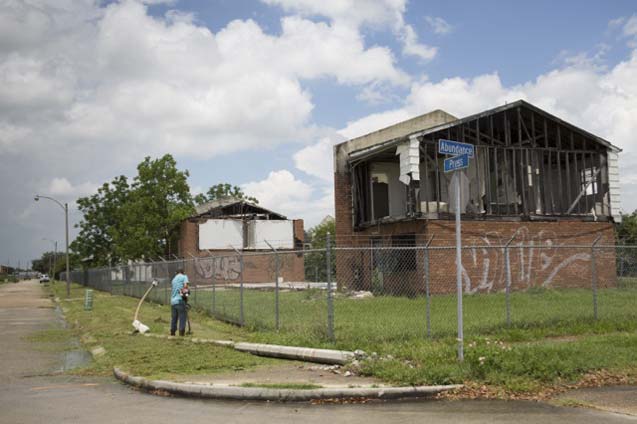
Shannon Rainey lives in a house that was built on top of a Superfund site in the Upper Ninth Ward of New Orleans.
“I bought my house when I was 25, and thirty years later, I still can’t get out,” she told DeSmogBlog.
Rainey’s home in Gordon Plaza is part of a subdivision developed by the city in 1981 on top of the Agriculture Street landfill. No one disclosed to the buyers that their new homes were built on top of a dump that was closed in 1965.
Rainey has a view of two other city-owned properties also built on the landfill: the shuttered Morton Elementary School and Press Park, an abandoned housing project developed by the Housing Authority of New Orleans (HANO).
“If it were white folks back here, this would be all gone,” Rainey says bluntly.
Shannon Rainey talks about life in Gordon Plaza.
Press Park was built by the Drexel Development Corporation for the housing authority six years after the landfill closed. It had 237 townhouses.
The housing authority marketed Press Park’s “new, affordable townhouses to striving black families,” according to the Lens. The agency instituted programs enabling low-income public housing residents to become homeowners.
Since Hurricane Katrina flooded the area almost nine years ago, the housing project has been deserted. A partial demolition of the buildings began at the end of March.
“Roughly 30 percent of the site (66 units) will remain once the demolition of HANO-owned buildings is completed,” Lesley E. Thomas, public information officer for the housing authority, told DeSmogBlog.
The remaining units belong to former residents who took advantage of a rent-to-own program. Since Press Park was never redeveloped, no one ever moved back in, though one former resident did fix his unit.
Residents in Gordon Plaza are not impressed with the partial tear down. They have been asking for years for all the blight to be removed. A former gymnasium next to the Morton school stands wide open. Inside is an assortment of illegally dumped items along with elaborate paintings on the walls. Many worry about their kids playing anywhere in the area.
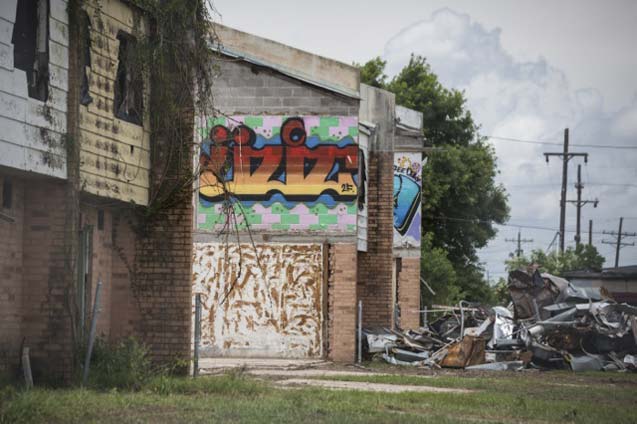 Graffiti covered townhouse in Press Park. ©2014 Julie Dermansky
Graffiti covered townhouse in Press Park. ©2014 Julie Dermansky
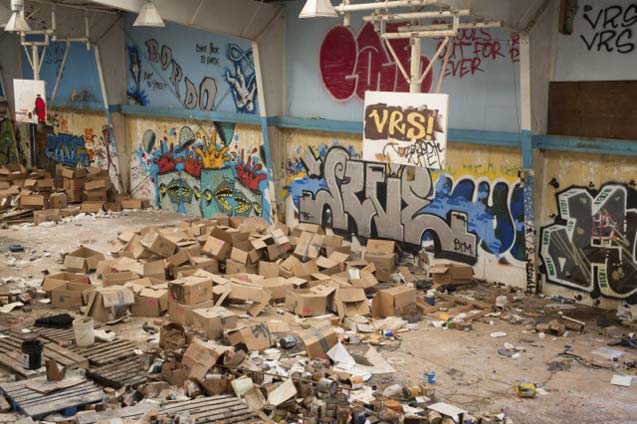 Abandoned gymnasium next to the Morton Elementary School. ©2014 Julie Dermansky
Abandoned gymnasium next to the Morton Elementary School. ©2014 Julie Dermansky
Rainey and many of her neighbors have been fighting for a buyout since the Environmental Protection Agency ( EPA) gave the area Superfund status in 1994. The EPA Superfund program gives the agency the authority to clean up abandoned hazardous waste sites.
Without buyouts, relocating is impossible for most of them since their homes have little resale value.
The EPA’s testing in 1993 found higher-than-allowed levels of lead, arsenic and polychlorinated aromatic hydrocarbons. It was only then when the city closed the Morton School, although according to legal documents, the EPA found evidence of contamination as early as 1986, reported the Lens.
“Instead of relocation, the community got a remedy,” environmental scientist Wilma Subra told DeSmogBlog. She worked for the community as a technical advisor.
“We presented plans for the city and state and the EPA to consider instead of a clean up — but the city squashed it. The EPA chose to remove the top soil and replace it for $42.8 million instead of buying the people out.”
Subra did a lot of testing in the area following Katrina. The results indicated the remediation work was not adequate.
“In areas where they replaced a few feet of soil, the storm opened it all up. A toxic sludge covered everything,” she said.
Subra’s tests showed the sediment sludge contained polynuclear aromatic hydrocarbons and heavy metals and the soil had high levels of dioxins.
“People who have remained there are still being exposed to carcinogenic chemicals, ” Subra said. “The waste is right under the surface in the soil in people’s yards.”
Members of the community took part in a class action lawsuit filed against the City of New Orleans, the Housing Authority of New Orleans and numerous insurance companies in 1993. Despite winning a favorable judgment against the defendants, the case is still in the court system.
In 2006, Civil District Court judge Nadine Ramsey declared the neighborhood “uninhabitable” and “dangerous.” She ruled in favor of the plaintiffs, holding the agencies involved liable for emotional distress and loss of property value.
However, only the nine original plaintiffs and the lawyers in the class action were granted funds from the initial settlement. The rest have been in limbo ever since.
 Blighted units remains standing in Press Park, a city run housing project, after a partial demolition of the projects is nearly completed. ©2014 Julie Dermansky
Blighted units remains standing in Press Park, a city run housing project, after a partial demolition of the projects is nearly completed. ©2014 Julie Dermansky
Despite the danger from toxins remaining in the area, government funds were earmarked for rebuilding, not relocating. Gordon Plaza homeowners had no choice but to rebuild or walk away. However, grants offered to other residents in the city to lift their homes to protect them from future flooding, were denied. Digging in the area’s toxic ground is forbidden.
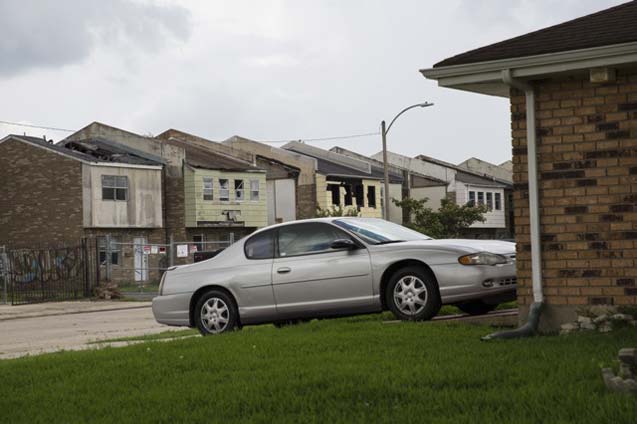 Homeowners in Gordon Plaza live across from the remains of Press Park nearly nine years after Katrina. ©2014 Julie Dermansky
Homeowners in Gordon Plaza live across from the remains of Press Park nearly nine years after Katrina. ©2014 Julie Dermansky
An April 2013 Federal Emergency Management Agency report reconfirmed that the topsoil remediation the EPA attempted didn’t work. The report states:
“Press Park is situated within a portion of the USEPA Agriculture Street Landfill, which is designated as a Superfund site by the USEPA. This site has been partially remediated. However, the soils under the parking areas, driveways, and building foundations still contain the following contaminants of concern: lead, arsenic and CPAHs. Additionally, the structures are dilapidated and serve as a haven for crime, vagrancy, and vermin that could potentially spread diseases.”
Rainey has repeatedly invited New Orleans Mayor Mitch Landrieu to come and visit but she never gets an answer.
“It is a disgrace, a clear case of racial discrimination. The city would never leave white folks back here like this,” she says.
The mayor’s public relations office didn’t respond to any of DeSmogBlog’s questions, saying they could not comment about ongoing litigation. The Board of Education didn’t get back to DeSmogBlog despite repeated calls and e-mails asking if there were plans to tear down the Morton Elementary School.
Rainey and her neighbors told DeSmogBlog they have invited representatives from the city and state to visit and have been repeatedly rebuffed. Even their lawyers don’t return their calls.
The group’s class action attorneys failed to respond to DeSmogBlog when asked for any current information about the ongoing litigation.
“The lawyers got their money in 2006 and don’t care,” Rainey said. The lead attorney, Suzette Bagneris, has since retired.
The Bagneris firm’s site states: “There is no money to distribute to Class Members at this time” and “the next court date is set for October 2014”.
“My situation is tearful, depressing, embarrassing and nightmarish,” Janice Stemley, Gordon Plaza resident, told DeSmogBlog.
She brought her mother to live with her, hoping to give her a better life, before she was aware of the danger from the toxins. Her mother got cancer and died.
“We are the forgotten part of New Orleans. We have been living on toxic waste for thirty years,” Rainey says.
 Gordon Plaza residents living on toxic land. ©2014 Julie Dermansky
Gordon Plaza residents living on toxic land. ©2014 Julie Dermansky
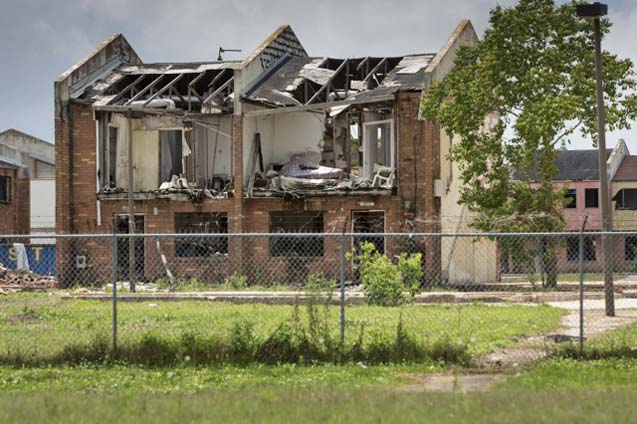 Furniture remains in townhouses almost nine years after Hurricane Katrina. ©2014 Julie Dermansky
Furniture remains in townhouses almost nine years after Hurricane Katrina. ©2014 Julie Dermansky
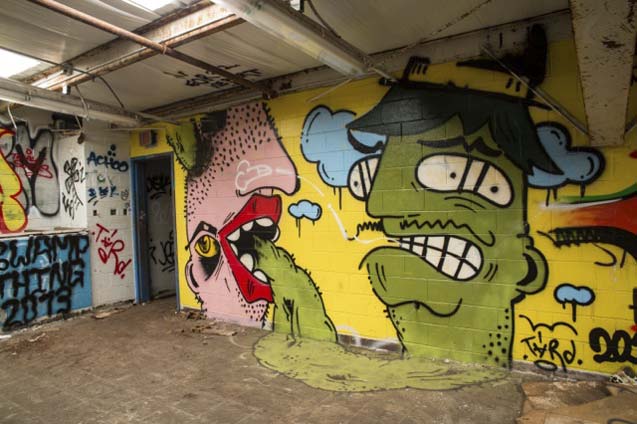 A mural in an abandoned gymnasium next to the Morton Elementary school. ©2014 Julie Dermansky
A mural in an abandoned gymnasium next to the Morton Elementary school. ©2014 Julie Dermansky
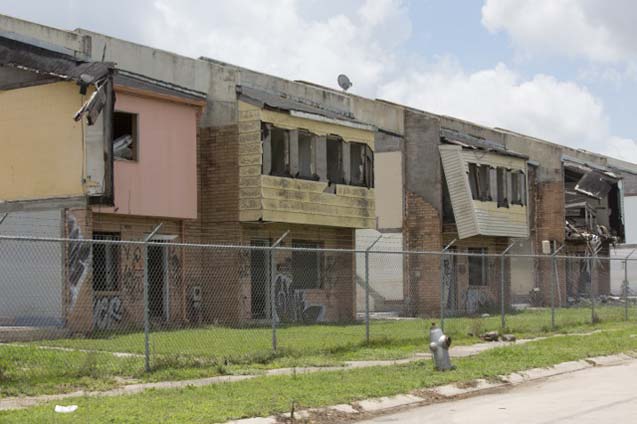 A row of blighted units remain in Press Park, after a partial demolition of the projects is nearly completed. ©2014 Julie Dermansky
A row of blighted units remain in Press Park, after a partial demolition of the projects is nearly completed. ©2014 Julie Dermansky
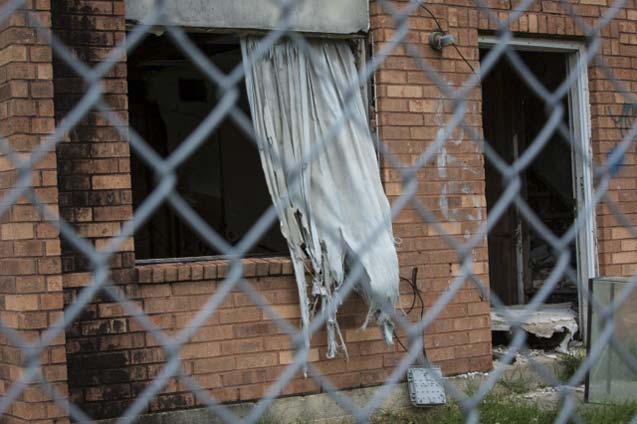 Curtains in the window of a townhouse in Press Park nearly nine years after Katrina flooded the area. ©2014 Julie Dermansky
Curtains in the window of a townhouse in Press Park nearly nine years after Katrina flooded the area. ©2014 Julie Dermansky
We’re resisting Trump’s authoritarian pressure.
As the Trump administration moves a mile-a-minute to implement right-wing policies and sow confusion, reliable news is an absolute must.
Truthout is working diligently to combat the fear and chaos that pervades the political moment. We’re requesting your support at this moment because we need it – your monthly gift allows us to publish uncensored, nonprofit news that speaks with clarity and truth in a moment when confusion and misinformation are rampant. As well, we’re looking with hope at the material action community activists are taking. We’re uplifting mutual aid projects, the life-sustaining work of immigrant and labor organizers, and other shows of solidarity that resist the authoritarian pressure of the Trump administration.
As we work to dispel the atmosphere of political despair, we ask that you contribute to our journalism. Over 80 percent of Truthout’s funding comes from small individual donations from our community of readers, and over a third of our total budget is supported by recurring monthly donors.
You can help by giving today. Whether you can make a small monthly donation or a larger gift, Truthout only works with your support.